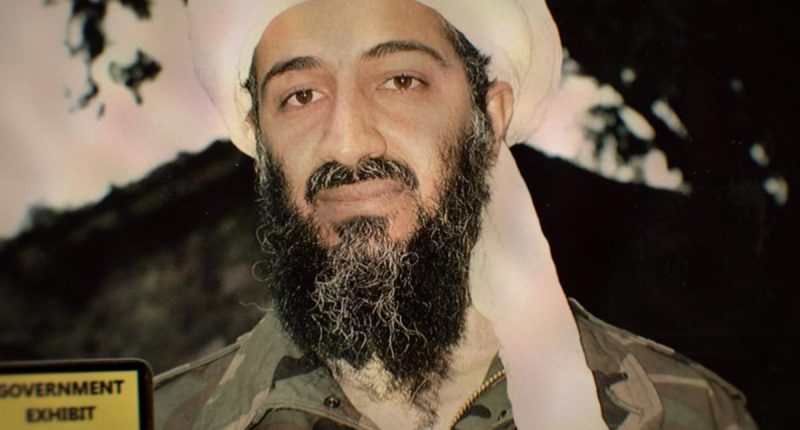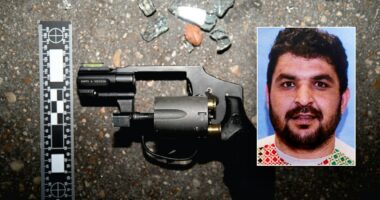Share this @internewscast.com
The three-part docuseries American Manhunt: Osama Bin Laden, directed by Mor Loushy and Daniel Sivan, delves into the extensive search for Osama bin Laden, the al-Qaeda leader and mastermind behind the 9/11 attacks. Considered a significant threat since the Clinton era, bin Laden orchestrated assaults on the USS Cole and U.S. Embassies in Kenya and Tanzania. Receiving support from the Taliban in Afghanistan, he skillfully evaded U.S. special forces, even after many regions were reclaimed from Taliban control. His evasion finally ended when a SEAL team took him down in Pakistan on May 2, 2011.
Opening Shot: “September 11, 2001. 08:46 AM.” The screen shows the iconic footage of the first aircraft hitting the Twin Towers, captured from a street perspective.
The Gist: Beginning on 9/11, the first episode revisits what intelligence agencies understood about bin Laden and al-Qaeda before the attacks. Interviews with key CIA figures and other intelligence personnel from that era reveal the burden of responsibility felt post-9/11. The episode also covers the military strategies employed by special forces who deployed to Afghanistan weeks after the attacks, aimed at supporting local warlords and Northern Alliance fighters to dismantle the Taliban and potentially expose bin Laden’s whereabouts.
But while the Taliban retreated quickly, bin Laden was much more difficult to find. The episode ends with the siege at Tora Bora, where bin Laden was thought to be hiding. Three weeks of street battles and airstrikes caused a lot of destruction, but the ultimate goal wasn’t achieved.
What Shows Will It Remind You Of? American Manhunt: Osama Bin Laden is the third in the American Manhunt series, following seasons discussing the Boston Marathon bombers and the O.J. Simpson case. Kathryn Bigelow’s 2012 film Zero Dark Thirty covers some similar ground, and recreates the raid on Bin Laden’s compound in a manner guaranteed to take your breath away.
Our Take: The stance taken in the first episode of American Manhunt: Osama Bin Laden is that, with the help of air support, the CIA special forces had bin Laden in their sights in Tora Bora, but a territorial reaction from Donald Rumsfeld, President George W. Bush’s defense secretary, kept them from going in with the troops they needed to capture the al-Qaeda leader.
It’s interesting that those first months of the manhunt are portrayed that way. It’s been almost a quarter century since those first months in Afghanistan, and the American public only really knew that the invasion wasn’t the usual swarm of ground troops that we usually saw. The idea that bin Laden was eluding such overwhelming airstrikes, though, seemed to be puzzling to the public. Little did we know that the Bush administration, so strong with the language about rounding up “evildoers”, was so reluctant to commit ground troops in Afghanistan. It would have been good to hear the perspective from someone in Rumsfeld’s DOD about why that was.
The other two episodes will likely discuss how, after bin Laden escaped Tora Bora, al-Qaeda began to be “franchised”, with sleeper cells throughout the Western world, and likely were responsible for attacks in London and Madrid, among other places. The third episode will discuss the operation that finally killed bin Laden, and the risks then-President Obama took to give the order for the SEAL team to go in.
But what we also expect from those episodes are a through-line of frustration that bin Laden kept getting away, and that the Bush administration never got the satisfaction of bringing him down. What we hope is that frustration comes with some self-reflection about how the U.S. went about their operations in Afghanistan.
Sex and Skin: None.
Parting Shot: We see the video of bin Laden that came out in April of 2002, showing that he survived Tora Bora and that he is still determined to kill Westerners.
Sleeper Star: We’re giving this to Tracy Walder, who was in the CIA’s counterterrorism operation that controlled drone strikes, because not only was she controlling drones dropping bombs when she was fresh out of college, but she got that job because the agency appreciated the leadership she exhibited in her sorority at USC.
Most Pilot-y Line: That being said, it’s amazing to think that the CIA is hiring people and giving them control of bomb-laden drones based on the fact that they were vice president of a sorority, even if it’s a large one at a major university.
Our Call: STREAM IT. American Manhunt: Osama Bin Laden is informative, to be sure, and it gives insight into operations most people in the US knew nothing about. But it’s certainly not trying to play things down the middle, letting the people they interviewed point fingers without giving the people they point fingers to the chance to respond.
Joel Keller (@joelkeller) writes about food, entertainment, parenting and tech, but he doesn’t kid himself: he’s a TV junkie. His writing has appeared in the New York Times, Slate, Salon, RollingStone.com, VanityFair.com, Fast Company and elsewhere.
(function(d, s, id) {
var js, fjs = d.getElementsByTagName(s)[0];
if (d.getElementById(id)) return;
js = d.createElement(s); js.id = id;
js.src = “//connect.facebook.net/en_US/sdk.js#xfbml=1&appId=823934954307605&version=v2.8”;
fjs.parentNode.insertBefore(js, fjs);
}(document, ‘script’, ‘facebook-jssdk’));
















